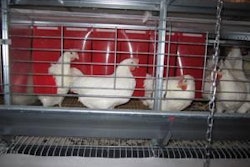
The role that rodents and flies can play as disease vectors has measures for their control receiving more attention over the last few years, because these pests can be responsible for carrying Salmonella enteritidis into the layer house. Robert Rowland, pest control specialist, IVESCO, said that when poultry primary breeders took steps to produce Salmonella-free eggs they demonstrated that it was possible to keep rodents out of poultry houses.
“We showed 28 years ago with primary breeders that you can have poultry farms without rodents,” Rowland said. “It is possible, but most people still think that it isn’t. If you have a good preventative program and stick with it, you don’t ever have to see rodents inside your building.”
Christian Bagocius, business development manager, Motomco, works with producers in eight western states on rodent control programs. “We recommend a three-foot sterile border around the perimeter of the house. The premier border is crushed rock or cement; spraying the ground to kill the vegetation and have bare dirt would be next, and last would be cutting the vegetation really short,” Bagocius said. The sterile border creates a natural barrier, because rodents don’t like to be out in the open and exposed to predators. If rodents cross the barrier they will move along the exterior wall of the building looking for a way to get in. Perimeter bait stations should be placed every 50 feet along the exterior wall of the building. Bagocius also said that the area around and between buildings needs to be kept mowed, and no equipment should be left around or leaning up against buildings.
Maintain the exterior
The exterior of the buildings need to be maintained so that there are no holes or gaps that rodents can use to gain entry into the building. Bagocius said that welded seam hardware cloth with no greater than one quarter inch openings should be used to exclude rodents from areas like vents and soffits.
Selecting the right poisoned bait to use in traps plays a role in excluding rodents from a poultry house, according to Rowland. “You have to select the products that rodents will crawl over spilled feed to get to,” he said. Complicating the bait selection decision, Rowland said, is the fact that what rodents like can change over time. Mice are more willing to try new things than rats are, but in order for a bait to be effective, the animal has to eat enough to kill them.
Coping with deep-pit houses
Once inside the poultry house, rodents will look for food, water and a place to nest. Deep pit poultry houses can provide a big rodent control challenge for producers because dry manure piles under the cages are great for controlling flies, but they can provide lots of nesting space for rodents. Rowland said that to control rodents in a pit house you have to go down into the pit weekly and look for tunnels into the manure pile. Any tunnels should be baited to take care of the rodents that dug them. He said that growers should also look for fly larvae in the manure pile. “You can’t haphazardly take these steps; you have to do it on a regular program,” he said.
“Controlling rodents in the pit of deep pit houses is difficult,” Bagocius said. “Wherever you have an unlimited supply of food, water and harborage, you will have rodents.” He said that live catch traps and snap traps can be strategically placed around the manure piles in a pit house, since most houses do have room for them in between the manure piles. Bait stations, live traps and snap traps located inside the poultry house provide a last line of defense trying to keep the rodents from coming into contact with the layers.
Fly control
Fly control used to be more difficult than rodent control, according to Rowland. The introduction of insect growth regulator products has changed all this. IGR products can be sprayed on manure to keep the larvae from developing and this breaks the life cycle. Rowland said that when using IGR products you still have to take other steps for controlling the adults and manure management still plays a key role, but the entire process has gotten easier.
Preparing for an FDA inspection
FDA inspections of egg farms checking for compliance to the Egg Safety Rule have provided a stimulus for many farms to recheck their pest control programs. Monitoring rodents and fly populations in the layer house is required by the Egg Safety Rule. The first thing that growers should do, according to Rowland, is check their paperwork, because that is the first thing the FDA inspectors will do. Read your pest control programs and make sure you are following them and documenting all of your checks.
SE monitoring of the environment inside the layer house is part of the Egg Safety Rule and United Egg Producers' 5 Star program. Any SE-positive sample requires that shell eggs be diverted, and this has a cost to the producer and has provided an incentive to take pest control to another level. “Growers have to take it (rodent control) seriously now that they know the consequences of an environmental positive and diverting the eggs,” Bagocius said.
“Facilities had to get better, so they did,” Rowland said.
Fortunately, doing a better job of pest control on your farm doesn’t really have to cost more money long term, Rowland said, “When you are in cleanout mode, reducing the number of flies and rodents, it can get pricey for the control measures, but long term you actually wind up spending substantially less because you never have populations that get out of control.”


















